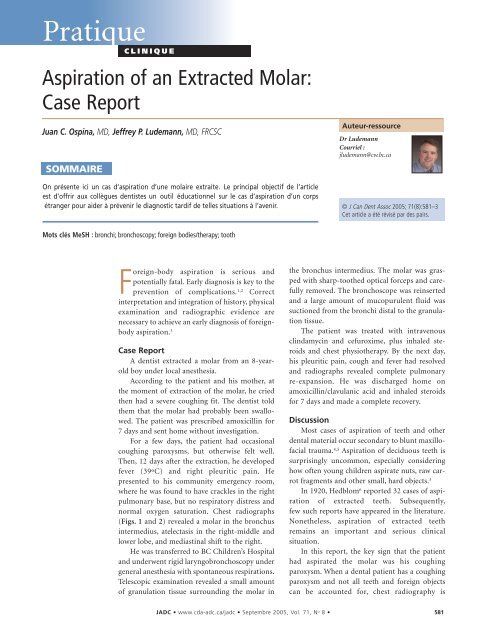JADC - Canadian Dental Association
JADC - Canadian Dental Association
JADC - Canadian Dental Association
You also want an ePaper? Increase the reach of your titles
YUMPU automatically turns print PDFs into web optimized ePapers that Google loves.
Pratique<br />
CLINIQUE<br />
Aspiration of an Extracted Molar:<br />
Case Report<br />
Juan C. Ospina, MD, Jeffrey P. Ludemann, MD, FRCSC<br />
SOMMAIRE<br />
On présente ici un cas d’aspiration d’une molaire extraite. Le principal objectif de l’article<br />
est d’offrir aux collègues dentistes un outil éducationnel sur le cas d’aspiration d’un corps<br />
étranger pour aider à prévenir le diagnostic tardif de telles situations à l’avenir.<br />
Mots clés MeSH : bronchi; bronchoscopy; foreign bodies/therapy; tooth<br />
Foreign-body aspiration is serious and<br />
potentially fatal. Early diagnosis is key to the<br />
prevention of complications. 1,2 Correct<br />
interpretation and integration of history, physical<br />
examination and radiographic evidence are<br />
necessary to achieve an early diagnosis of foreignbody<br />
aspiration. 3<br />
Case Report<br />
A dentist extracted a molar from an 8-yearold<br />
boy under local anesthesia.<br />
According to the patient and his mother, at<br />
the moment of extraction of the molar, he cried<br />
then had a severe coughing fit. The dentist told<br />
them that the molar had probably been swallowed.<br />
The patient was prescribed amoxicillin for<br />
7 days and sent home without investigation.<br />
For a few days, the patient had occasional<br />
coughing paroxysms, but otherwise felt well.<br />
Then, 12 days after the extraction, he developed<br />
fever (39ºC) and right pleuritic pain. He<br />
presented to his community emergency room,<br />
where he was found to have crackles in the right<br />
pulmonary base, but no respiratory distress and<br />
normal oxygen saturation. Chest radiographs<br />
(Figs. 1 and 2) revealed a molar in the bronchus<br />
intermedius, atelectasis in the right-middle and<br />
lower lobe, and mediastinal shift to the right.<br />
He was transferred to BC Children’s Hospital<br />
and underwent rigid laryngobronchoscopy under<br />
general anesthesia with spontaneous respirations.<br />
Telescopic examination revealed a small amount<br />
of granulation tissue surrounding the molar in<br />
Auteur-ressource<br />
Dr Ludemann<br />
Courriel :<br />
jludemann@cw.bc.ca<br />
© J Can Dent Assoc 2005; 71(8):581–3<br />
Cet article a été révisé par des pairs.<br />
the bronchus intermedius. The molar was grasped<br />
with sharp-toothed optical forceps and carefully<br />
removed. The bronchoscope was reinserted<br />
and a large amount of mucopurulent fluid was<br />
suctioned from the bronchi distal to the granulation<br />
tissue.<br />
The patient was treated with intravenous<br />
clindamycin and cefuroxime, plus inhaled steroids<br />
and chest physiotherapy. By the next day,<br />
his pleuritic pain, cough and fever had resolved<br />
and radiographs revealed complete pulmonary<br />
re-expansion. He was discharged home on<br />
amoxicillin/clavulanic acid and inhaled steroids<br />
for 7 days and made a complete recovery.<br />
Discussion<br />
Most cases of aspiration of teeth and other<br />
dental material occur secondary to blunt maxillofacial<br />
trauma. 4,5 Aspiration of deciduous teeth is<br />
surprisingly uncommon, especially considering<br />
how often young children aspirate nuts, raw carrot<br />
fragments and other small, hard objects. 3<br />
In 1920, Hedblom 6 reported 32 cases of aspiration<br />
of extracted teeth. Subsequently,<br />
few such reports have appeared in the literature.<br />
Nonetheless, aspiration of extracted teeth<br />
remains an important and serious clinical<br />
situation.<br />
In this report, the key sign that the patient<br />
had aspirated the molar was his coughing<br />
paroxysm. When a dental patient has a coughing<br />
paroxysm and not all teeth and foreign objects<br />
can be accounted for, chest radiography is<br />
<strong>JADC</strong> • www.cda-adc.ca/jadc • Septembre 2005, Vol. 71, N o 8 • 581
















